 Have you ever added hidden compartments to your work……. More Amazing #Woodworking Projects, Tips & Techniques at ►►► www.woodworkerz.com
Have you ever added hidden compartments to your work……. More Amazing #Woodworking Projects, Tips & Techniques at ►►► www.woodworkerz.comvia Tumblr https://davidpires578.tumblr.com/post/159953583819
 Have you ever added hidden compartments to your work……. More Amazing #Woodworking Projects, Tips & Techniques at ►►► www.woodworkerz.com
Have you ever added hidden compartments to your work……. More Amazing #Woodworking Projects, Tips & Techniques at ►►► www.woodworkerz.com This da Vinci-like table table is based on a design patented in 1835. Just turning the table one quarter of a rotation will double its surface area. Its operation is simple and beautiful–Everything about this table is easy, except its cost ($50,000) and its construction, which takes many months.
This da Vinci-like table table is based on a design patented in 1835. Just turning the table one quarter of a rotation will double its surface area. Its operation is simple and beautiful–Everything about this table is easy, except its cost ($50,000) and its construction, which takes many months.I am trying to keep my promise to myself to get back to posting when I have made progress on some of my projects. With that said, I had a pretty productive weekend and wanted to share some of what I did with you all.
I spent most of Saturday working up in my shop. I had some orders to go out, and I have a large project that I am working on with another artist that I want to stay on top of and chip away at gradually. That way, by working it in with my other work, I hardly notice the time spent doing things and also can keep up while accomplishing my own work. This way of multi-tasking is really key to my succeeding in getting everything accomplished that I want to accomplish. Besides – switching gears keeps me fresh and excited about things. As each new project emerges, I love the excitement of seeing it progress.
On Saturday evening, I finished painting my third and final owl for my set of three owl designs. This one I call “Booboo”.
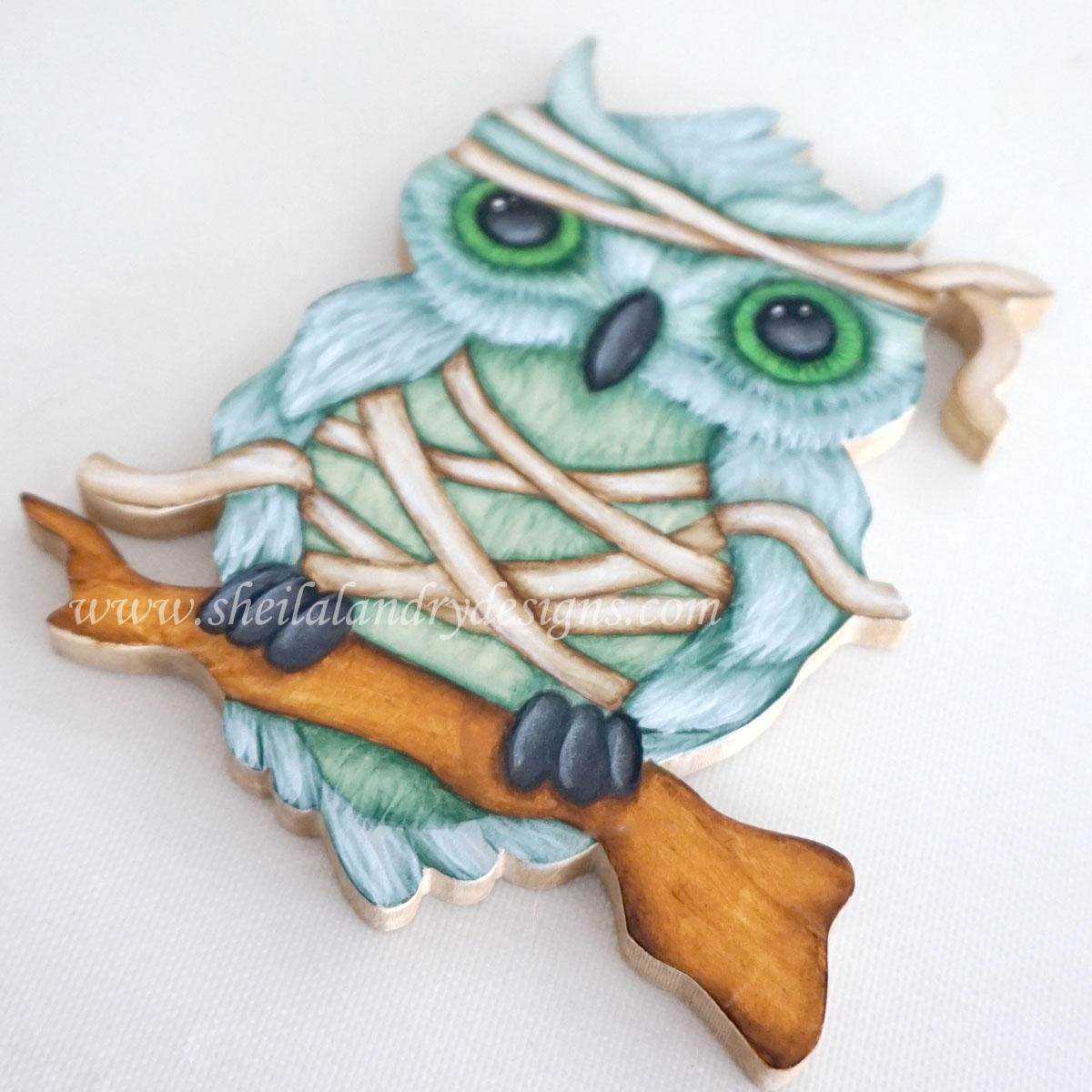
He was a challenge, to say the least, but I do like how he came out.
Now that the three main figures were done, I thought it would be fun to put them in a setting. This way they could be painted either on my own surfaces or on anything that my customers wished. I like offering the versatility of my patterns and designs. I hope it inspires people to use them in several different ways.
I choose my SLDPK141 - Round Pumpkin Bevel Cut Ornaments. I thought they would be perfect for what I had in mind.
First I created some cool backgrounds:

Next, I blocked in the figures of my three owls. This will give you a little idea of how they will look when finished.
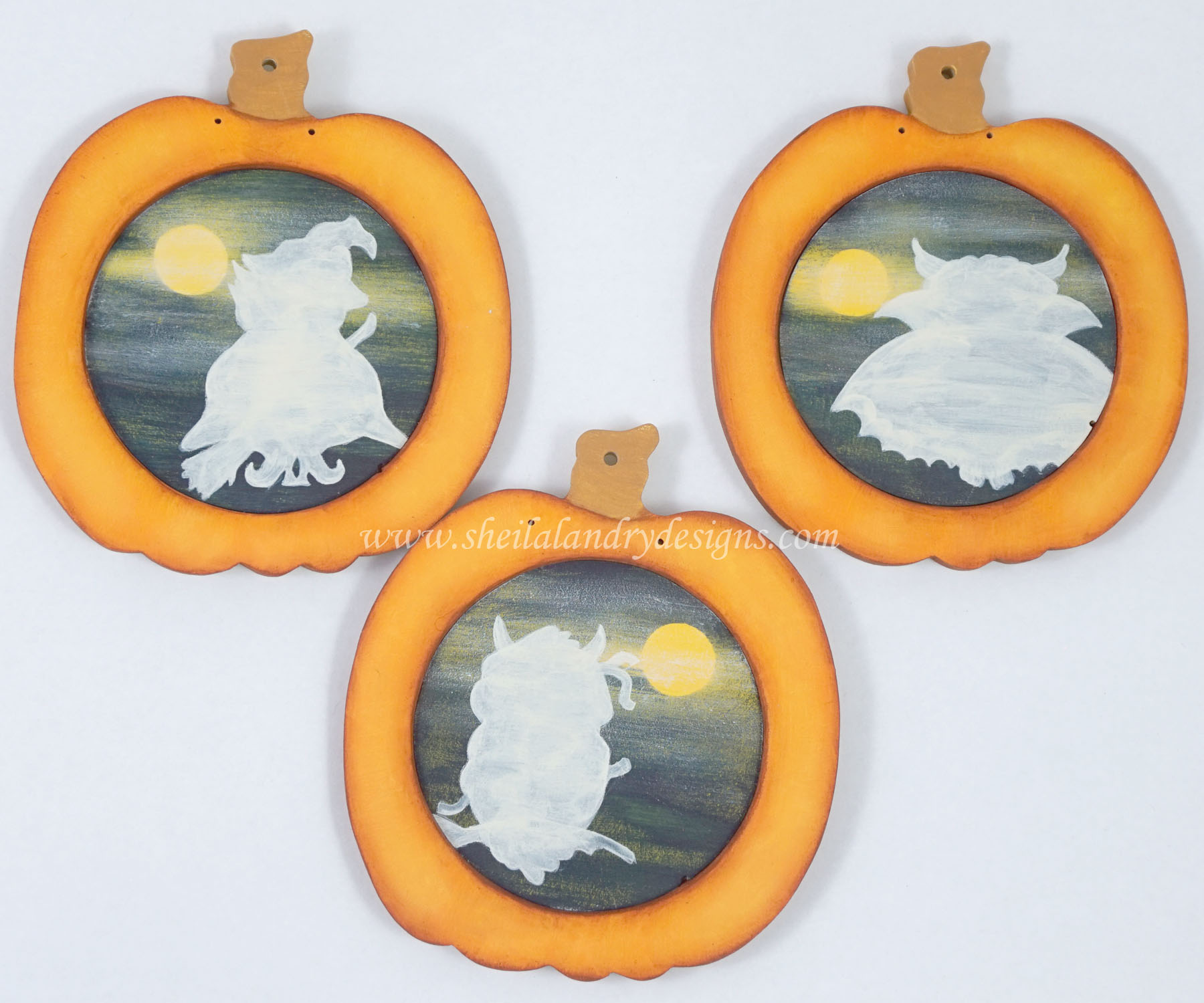
Oddly enough, this took quite a while to get to this point.
I began painting the Broom Hilda owl first. This time I was taking step-by-step photos as I did each layer, so I could use them when creating the pattern packet. When I design, the first time around mostly consists of “trial and error” and it is rare that I can just paint something once and have it make sense for a pattern. I typically paint the designs a second or even third time in order to document the steps and put them into an order that will make sense to my customers. It is a bit of a process.
By the end of the evening last night here is where I wound up:
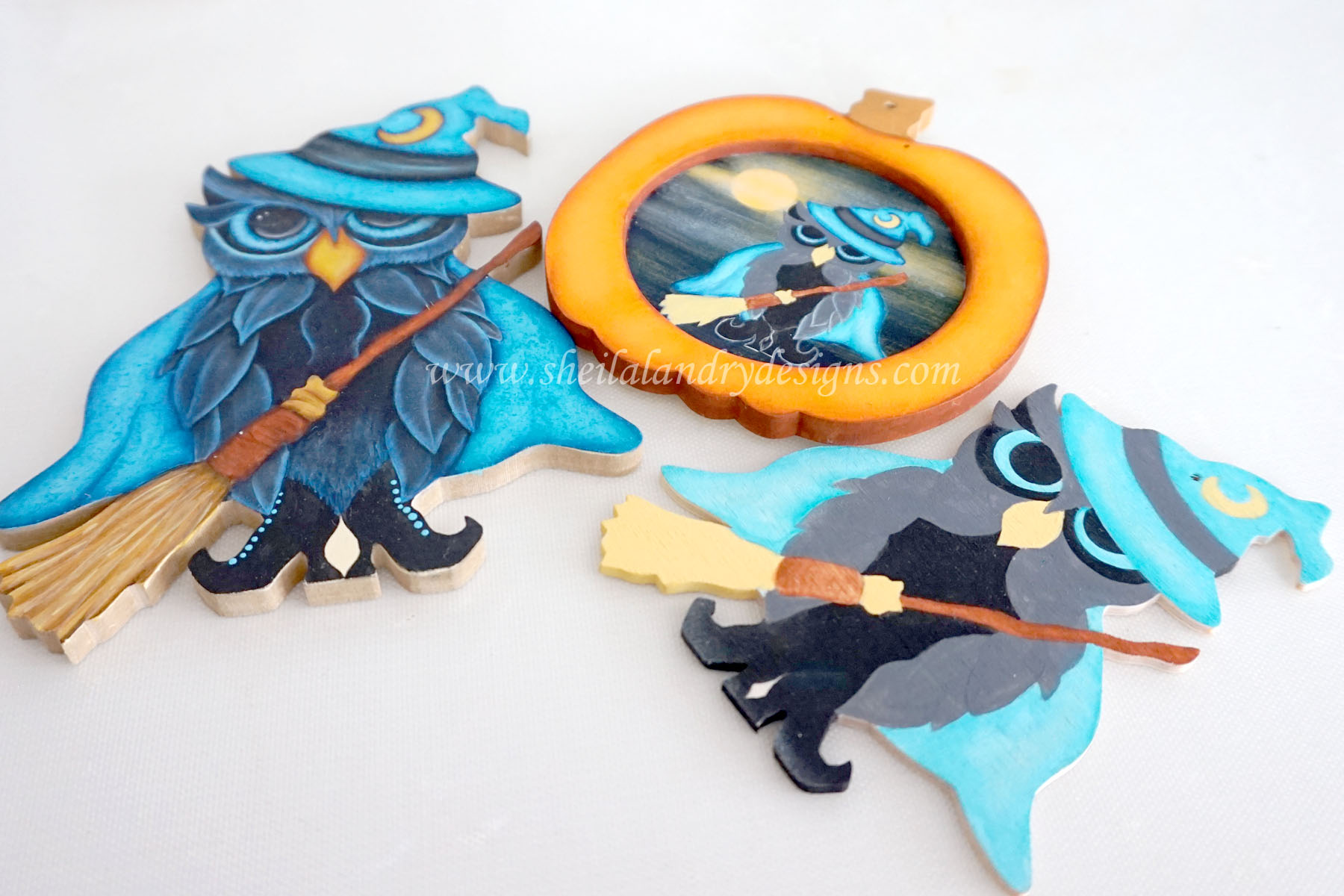
So far, pretty good.
I am going to continue to work on these for the next day or so and the pattern will be available as soon as they are done. :)
Keith has also been busy creating some new designs. He has a new Biblical plaque. (SLDK710 - Let it shine - Matthew 5:14-16)

He also has a beautiful new Eagle desk clock. (SLDK718)
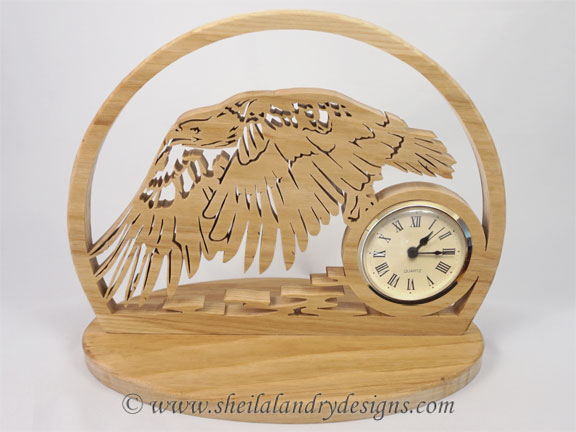
Finally, Keith created a pattern set that includes three plaque designs (SLDK720 - Professional Grandparents)
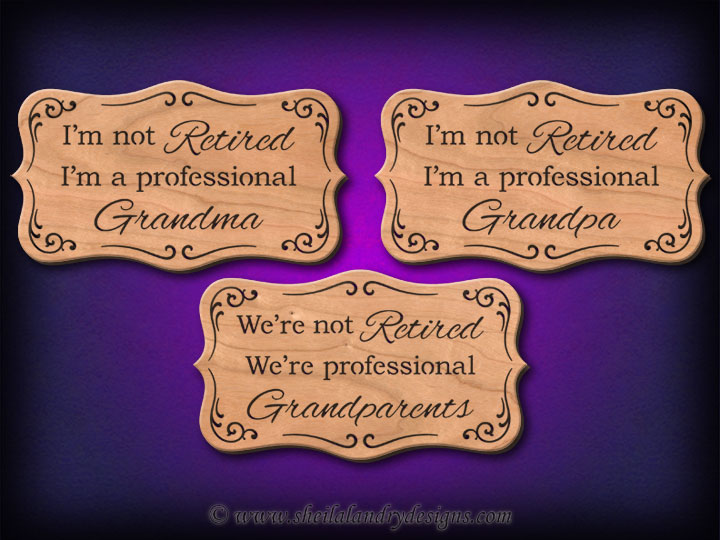
We hope you all enjoy the new designs.
Today will be crazy/busy for me. I have to do my mail, take a jaunt to Yarmouth for some medicine for my kitty Richard (who is doing better, but on maintenance medicine) and then get back to my painting and creating my patterns. So many have shown interest in the new designs and I want to get the patterns and wood pieces done as soon as possible. It is never too early to work ahead for the seasons I am finding.
It is a beautiful day today. The temperature is warm and it is sunny and calm. A wonderful way to begin the week. I hope you all have a wonderful week as well and thank you all for your comments and encouragement on my new designs. I really do appreciate it.
Happy Monday to you all!
Now working on fitting the bifold doors to the client’s cabinet, adjusting door width at the sides of the stiles, as before:
It’s funny how we fall into and out of habits. There are times when this happens with little effort or thought, and other times (usually when trying to develop positive habits) that it seems like a chore to follow through with things each day. There are also times in our lives when things change unexpectedly and along with it, our routines. I suppose that is part of living.
For the past several months, it seems that every time I post here I am apologizing for not posting as often as I used to. For many years (and 1800 posts) I began nearly every day with writing a blog post. There seemed to be so much that I wanted to share with you all. Not only about creativity, but about life in general. I think that in doing so, I was finding my own way through this world and writing about not only my creative experiences, but the puzzle pieces of my life falling together was something that I found to be very beneficial. Not only did it ground my own thoughts and life, but it helped with my business as well. It was all good.
I like to be optimistic and look on the bright side of things. I feel that the focus we set our sights on truly helps us in achieving our goals. Waking up with a positive outlook helped me in a very positive way through my life and even when things were not great, having a positive attitude kept me in a good place. The good feelings usually won over the bad ones and life was good. It was a formula that worked for me for a long, long time.
But when I lost my little kitty Pancakes last December, things somehow changed. I know that some of you will say that he was “only a cat” and that it shouldn’t affect me as much as it did, but if I learned anything this winter it is that we don’t always have control over how we react to things. Emotions are not always controllable. At times, we are at their mercy.
I found that no words that I could write would make me feel better. There was nothing that I could say that would alleviate the pain. After over four months since he died, I am only just now feeling as if I am beginning to cope with things. The pain is still there, but it is at a more manageable level. Since Pancakes was by my side nearly every day, all day, I am finally beginning to cope with doing things (just about everything) without him here. While Richard has picked up some of the slack and is himself recovering from nearly dying in December, he is still not Pancakes. There was only one Pancakes and he will always remain in my heart and my life.
Fortunately, this year has been our busiest to date. Even though I haven’t been designing much, the building blocks that I have been putting in place over the past years and months have (fortunately) began to come to fruition. That is the good part of things being a ‘process.’ Nothing happens quickly. Things need to develop and gel at their own speed. This is the part where patience is the most important. I realize that sometimes people who have their own businesses are desperate for quick results – either for economic reasons or other emotional reasons. But this isn’t usually the case and I believe that it may be the reason why so many businesses fail. The key ingredient is 'patience’ and for whatever the reason, it is not added into the equation when someone starts out on their own. However, without it, chances for success are very slim.
As I get older, I realize the importance of patience more and more in many aspects of life. It seems that the eagerness of my youth has played itself out, and has been replaced with a calmness that has allowed me to step back and let life play itself out as it should be. I find myself not pushing so hard for things that I want to achieve. Perhaps I am just getting better at reading the signs that are laid at my feet. Is this what “maturity” is? Is it learning that being in tune with the world around you is the best way to head? That allowing your life to follow the path that feels the most natural is perhaps the best direction? Lately, that is how I have been seeing things.
As you can see, I have spent much time these past months just thinking. I am fortunate that I have had a ton of 'busy work’ to keep me moving and working, without really having to be too creative. There is a lot to be said for production work. It allows us to engage another part of our beings into doing something positive while our heads and thoughts are able to rest and sort through things in our lives. At least that is how I feel that this time has affected me. At the end of these work days, my body has ached but there had been large piles of wood pieces that I had cut and I felt accomplished. It has been a good shift for me at a time when I needed to be busy without thinking too much. A time that I needed to sort my thoughts and heal. A time for emotional rest.
I am so grateful to you all for sticking with me.
I know things are getting better because I am beginning to feel my creativity returning. Not only do I have some ideas, but I have lots of ideas that are just screaming to be implemented. I think there must be a little space in my mind that has stored them through these past months and kept them safe until I was ready for them. Little by little I have felt the desire to create returning to me and this past week or so I have started to draw and paint my own designs again. It actually feels pretty good. Although I kept busy cutting wood and painting things created by others, there is something that is very satisfactory in creating something from my own thoughts. By allowing this part of myself to rest while I was healing and coping with the changes in my life, I think that it did me much good. I have felt more 'normal’ lately and as if I am getting back on track. I still respect that it is a process, but at least I feel as if I am heading in the right direction. I am very grateful and excited for the first time in a while. Things will be OK.
With all that said, I will get to showing you my new designs …
I am jumping ahead a couple of seasons to Halloween. I had so many cute ideas in my head last year and I didn’t get the opportunity to implement them, that I thought it would be a good place to start so I would feel a bit ahead of things. I think I enjoy working half a year or so ahead. Perhaps it is because I had done that when I designed for the magazines for over 20 years. It is familiar to me and comfortable.
My first pattern of this year I am calling “Owl at the Moon”. It will include three owls dressed as different characters or costumes. I will have more than three owls in this series and will have several packets with this theme, but these are the first two of the group, as I need to begin somewhere.
This is “The Count”:

They will be ornaments and can be used on a Halloween tree, wreath or other types of decoration. I am still figuring out the best way to market them so that they can be utilized to the fullest. My usual problem of “lots of versions” is rearing its ugly head and I am trying not to make things too complicated. I will probably offer three or four sizes of the pattern in the packet(s) so that people can use them how they wish. But this piece is just a prototype and is about 5" tall, allowing the amount of detail that I wanted to have in it. I suppose by the time I finish the first three, I will decide what is best. I also appreciate suggestions from you all as to how you would use them. If all else fails, I am happy to cut custom pieces for those who want them a certain size and thickness. So many options …
The next piece is one I call “Broom Hilda”:

I love her brilliant colors! I didn’t photograph her in my light box yet, as I will do that when I have the first set of three completed. But this photo shows the pretty turquoise and black/gray mix nicely and she looks just fabulous in person. I am happy with her.
I will be creating the third piece today. My cutting is pretty much caught up and I want to take a day just to paint. I haven’t done that in quite a while.
Thank you to all of you who have been so encouraging and patient with me over these past few months. Whether you are new to reading my blog or someone who has followed me for years, I want you to know you are appreciated. I hope to come back here to post more often and present both painting and woodworking projects to inspire you all. I don’t want to give any set timeframe, as I am not sure of the frequency that I will be here. I would rather wait until I feel that I have something inspiring for you all instead of just coming here to ramble on. Although, I love to hear from you as well.
We are heading into another weekend here and this morning felt more like spring than yesterday. Yesterday I awoke to about four inches of snow. While it isn’t really that unusual to have snow here in April, after the previous weeks of warmer weather, it was a little bit of a surprise. By the time Keith and I went for our walk in the afternoon, it was mostly gone though. Maybe it was one of the last hurrahs of winter and Mother Nature was just playing a trick on us. One would hope so, anyway.
I hope you all have a great weekend. I know I have some fun and creative things planned and I hope to focus on getting my next little owl painted. It will be a good one, I am sure.

Happy Friday to you all!
Doors, doors, doors…
Fitting the bifold doors has taken a fair while. Small adjustments were required to the frames of the doors respective of the carcase opening, as well as adjustments along the doors stiles to create suitable gaps between the leaves.
Here I’m giving my Genmyō plane a workout on one of the inner stiles:
Final post in this thread - - just kidding!
Moving along, moving along. Before I could bore out for the hinge bushings on the support stand’s sill, I had to assemble the sill frame together. The corners on the frame are Japanese mitered box joints with shachi sen, and this corner you see next was the first to be done, and incidentally was the one shown in the previous post, with my assurances that the miter gap would be gone once the pin was in place: